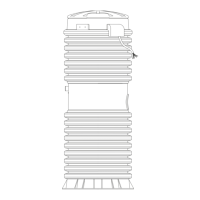80
Test Run
A test tank and panel (available from E/One) is recommended for run-testing the pump. The
test tank has a discharge assembly for the D series pumps, or slide face for the W series
pumps. A pressure gauge and ball valve should be added to operate the pump under
pressure. A two-tank setup with sump pump to pump water back to the test tank is ideal.
Contact the E/One Service Department for assistance. Testing the pump is very important.
1. Set the pump in the test tank and fill with water to the alarm level. Connect the EQD.
2. Open the discharge valve.
3. Hook the Amp probe around the black power lead to the pump (see Amperage Draw
Test).
4. Turn on the alarm power circuit breaker and verify the alarm is functioning. Note:
Wirelessly-controlled pumps require that both breakers (pump and alarm) are on for the
alarm to function properly.
5. Turn on the pump power circuit breaker. The pump should turn on immediately. At 0PSI,
the alarm should turn off in one to two minutes; the pump within 30 to 45 seconds after
the alarm.
6. Leave the circuit breakers on. Fill the tank until the pump turns on. Carefully close the
ball valve until the pressure gauge reads 40 PSI. The pump should shut off in
approximately 45 seconds (in a 24”-diameter tank).
7. Fill the tank again until the pump turns on. Carefully close the ball valve until the gauge
reads 35 - 40 PSI. The pump should shut off in approximately one minute.
The unit must be tested to pump against discharge pressure; note the amperage draw at each
pressure.
WARNING! Do not “deadhead” the pump by closing the valve completely. Damage and
personal injury may occur.
Note: At 0 PSI discharge pressure, the unit pumps approximately 15 GPM. At 40 PSI, it pumps
about 11 GPM, and at 60 PSI, about 9 GPM. Flow can be checked with a 5 gal pail and a stop
watch (15 GPM = 20 seconds; 11 GPM = 28 seconds; 9 GPM = 34 seconds)

